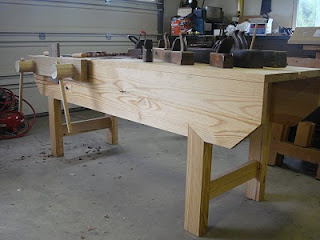




Well, here's my first saw build, complete except for the teeth. I actually made the blade for this about 6 months ago but just got around to making the handle this past week.
The saw plate is from a sheet of .018 1095 spring steel from McMaster-Carr. The steel comes with a blued finish which you could leave on if you wanted, I chose to sand it off and have a bright saw plate. I wanted this saw to have the look of an 18th century saw so when I cut the saw plate, I canted it, 1 5/8" at the toe, 1 7/8" at the heel. I did this with a floor model metal sheer. I chose a steel back for this saw instead of brass. It started out as a piece of 3/4" angle iron from Lowes. I slowly and carefully bent this closed in a machinist vise, moving it in slow increments from side to side being careful not to kink or bend the back crooked. This is the hardest part of the whole process. Once I got it bent closed, I shaped it, filed the imperfections out of it, and then sanded the file marks out. Then it was time to install the saw plate. I started with the saw back on the bench and the top heel corner of the saw plate inserted in the rear of the saw back at 90 degrees to it. I tapped that corner in and then worked my way toward the toe, tapping it down into the back as I went. The useable depth under the back is 1 1/8" at the toe and 1 3/8" at the handle.
The handle is black walnut and the shape is modeled after the Wenzloff Early Kenyon Saw. Made a paper pattern and attached it to the walnut with a glue stick, cut the handle to rough shape with a coping saw, then lots of work with a couple of rasp and a chisel, followed by progressively finer grades of sand paper. The finish is four coats of wipe on clear satin poly. Stumbled across the hardware at a True Value. Not sure what they're supposed to be used for, but they work pretty well as saw nuts. And less than a dollar a piece. Now I just have to find to nerve to cut the teeth. Trying to decide between 15 and 17 PPI.
This project has been a lot of fun and I'll definitely do some more. Really want to make a copy of the Tenon Saw shown in Smiths Key.












